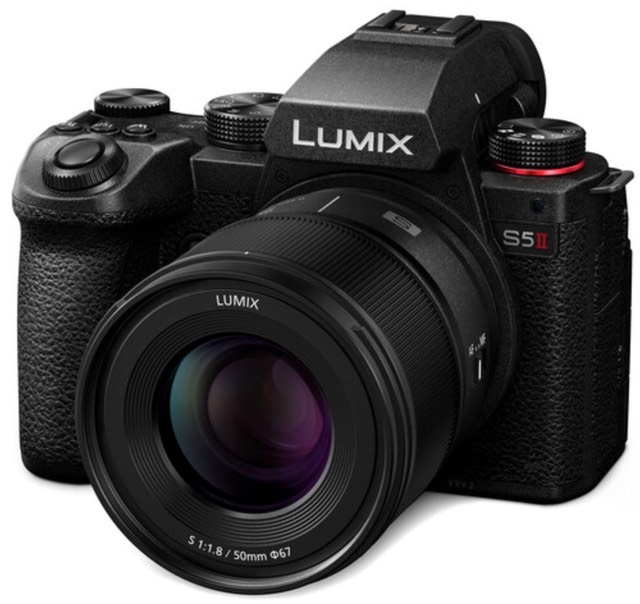
Panasonic today announced the S5 Mark II and IIx models, its third stab at establishing itself as a strong contender with a 24mp full frame camera. One key difference this time? A critical change in the autofocus system.
Yes, Panasonic has finally added phase detection to their cameras, now coupled with the DFD work they’ve done in the past and a human/animal subject detection capability. Obviously, this new focus system is one of those things that will need testing to see how it truly performs, but the hope of Pannyfans is that this finally brings them back into some form of competitiveness with the others, all of whom have been using phase detect technologies for some time now.
The other new features of the new models tend to relate to video. The Rear LCD now becomes articulating, for instance, while we get what takes literally pages of specifications to iterate all the video capabilities in even modest detail. Basically, the US$2000 S5 II can be thought of as a 6K/30P open gate camera or a 4K/60P camera, with a lot of other capabilities, including anamorphic support. The HDMI connector goes from Type C (mini) to Type A (full), as if to show the video changes off. The Iix version of the camera is US$200 more and adds raw video support, internal ProRes and All-I compressions, IP streaming, and video recording to an external SSD (via USB). You can update a II to include raw video output for US$200 update, but you don’t get the other things.
A few other aspects of the camera changed, as well. The EVF moves to a 3.68m dot OLED one, Bluetooth is upgraded to version 5BLE, and the image buffer appears to be deeper. Physical size of the new version is close to the original, but slightly bigger, but previous accessories still work.
Along with the new camera, Panasonic also announced a new US$799 Lumix 14-28mm f/4-5.6 macro lens. This brings Panasonic’s contribution to the L-mount to 13 autofocus lenses, and rounds out something that looks like a variable-aperture zoom set.
Commentary: Panasonic is still trying to find traction against the full frame competition. The S5 is usually compared against the Canon R6 Mark II, Nikon Z6 II, and the Sony A7 Mark IV. All these cameras have mature generations of phase detect autofocus, while the older Panasonic S5 was still using contrast detect (with Panasonic’s proprietary DFD technology). Since focus performance is something that’s easily noticed, Panasonic had a tough slog of it in the previous generation. At that competitive point, Panasonic was a distant fourth in terms of sales, despite the fact that the S5 was otherwise a very capable camera.
The question is whether the update changes anything.
Note the heavy emphasis on video changes. Amazingly, Nikon, who’s not known for being a video leader, was able to step in with the original Z6 and its Z6 II update to stake a claim at being one of the best 4K hybrids on the market (particularly so if you opted for the optional raw video update). Not only did Nikon leap towards the front of the pack, but it did so being the low-cost provider (the Z6 II’s pricing has been lower than that of Canon or Sony. (Caveat: for Christmas 2022, the S5 dropped to US$1500 while the Z6 II only dropped to US$1700.)
Pricing the S5 II at US$2000 puts improved video characteristics up against the Nikon Z6 II at the same price point. If Nikon ups their price to US$2400-2500 with their Z6 III update as I expect, that would put Panasonic as the low-price leader in 24mp full frame mirrorless.
Panasonic is known as a video leader, not just at the small, mirrorless camera end, but also at the big Hollywood- and Broadcast-production end. The thing Panasonic needs to preserve is its position in the professional video market, while along the way it needs to pick up new users who are looking at getting into video.
The problem I see is that Panasonic is mostly aiming at the wrong spot(s). The GH6 already hits where the S5 II tries to, so in some ways they’re competing with themselves in the small hybrid form factor. Panasonic, on the other hand, has no true entry vlogging-style camera at the moment, while Nikon and Sony do, and Canon’s coming soon. Meanwhile, Panasonic’s professional lineup needs a great deal of attention, too. They need to standardize on L-mount lenses on the big, pro cameras, much like Sony did with the E-mount many years ago.
To me, Panasonic is iterating a bit too slowly and without a clear product line differentiation. Their strategy feels more like whack-a-mole than clearly articulated. That, of course, doesn’t make the S5 II a bad camera. It just calls attention to the fact that Panasonic has a lot they need to do at the moment, and the S5 II, by itself, might not fix their real needs.
Since Canon and Sony have already iterated models at this product point, the ball is now in Nikon’s to show us what a Z6 III looks like.
